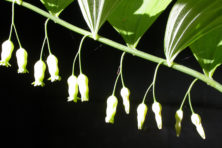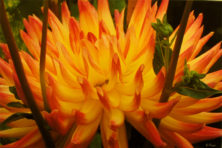Spring Buds
- Share
- Tweet
- Pin
- Share
In thinking back to the very first plant buds I came to know and enjoy, surely they were those of the Forsythia. Shortly after our new home was built in Kewaunee, my Dad planted two Forsythia shrubs, one next to the northwest corner of the house and the other on the southwest corner.
Eventually the buds of trees and shrubs will slowly begin to swell and, one day, sooner than we realize, the delicate winter silhouettes of trees will be hidden by a spectacular leaf mosaic. Many people are surprised to learn that these buds of deciduous and evergreen plants were completely formed as early as last August, developed in miniature and ready for a seven- to nine-month wait before their flowers, leaves and twigs would begin to emerge.
A spring didn’t go by without my parents cutting at a few large bouquets of the two-foot-long budding twigs to be forced indoors. My Dad was so skilled with pruning and shaping the shrubs around our home, but I can’t recall how he worked with the Forsythias. I think he kept both the plants to about six feet.
For quite a few years we’ve included in our annual spring rituals the indoor forcing bouquets of two-foot-long Balsam Poplar twigs. Within a few weeks after being brought inside, the dark, shiny, sticky, mahogany-colored buds will begin to exude sparkling amber droplets of pitch that will perfume every room with heady balsam-ness. It was our friend, Miss Emma Toft, who taught us this wonderful and simple practice.

The American Beech has long slender pointed buds.
History tells us that the Ojibwe Indians stewed the large spring buds (of Balsam Poplar) in bear fat, which yielded a salve used to cure earaches, head wounds, bruises and ulcers, and to soothe boils. The mixture was also rubbed onto the inside of the nostrils so that balsamic odors could flow through the respiratory passages, opening them in case of congestion from colds or bronchitis.
My favorite way of using the “Tacamahac”, another name for the Balsam poplar (Populus balsamifera) is to firmly squeeze one of the buds between my fingertips, then transfer the sweet-smelling resinous pitch to other parts of my hands. The fragrance lasts and lasts, an entire afternoon if you are careful to not wash your slightly sticky hands!
Buy a simple hand lens magnifier and take a closer look at the fine parts of the winter trees, stark, bare, but teeming with life. Don’t worry about removing a few twigs with their buds. A large Sugar Maple may have several million buds and it’s unlikely that more than about one-half of those will open during the spring. Nature has provided the trees and shrubs with back-up insurance against breakage due to winds and other forces.
The beautiful part of this simple study is the discovery of the distinctive shapes and colors of the various buds. Eventually, with practice, you will be able to identify a shrub or tree by one of its winter twigs. The maples, their buds in threes, and the American Beeches with their long, slender, stream-lined buds will be among the easiest to learn.
A closer look at a bud will reveal the several overlapping, tightly-contoured scales, somewhat like shingles, that enclose the developing leaves or flowers, of both. Their textures range from smooth and waxy to shiny and sticky, fuzzy and furry. These various coatings provide the all-important buds with winter-proofing – nature’s insulation and anti-freeze.
Do you know that trees have faces? Directly below each winter bud will be a scar indicating where last summer’s leaf was attached to the plant. The shape of each shrub or tree specie’s leaf scar is very distinctive and frequently resembles a tiny face. A series of dots within the leaf scar, the vascular bundle scars of last year through which fluids were carried to and from the leaf, often look like eyes, ears and a mouth.
On some trees it is a combination of the winter buds, plus last summer’s leaf scar that together comprise the face. One of my favorites is that of the Black Ash. Its terminal bud appears like a pointed cap, the two, roundish lateral buds look like the bulging eyes, the forward-facing bud is the nose, and finally the leaf scar looks for all the world like a broad grinning smile.
The bud scales of one bud encircle the twig. Consequently you can look at the twig section of last year or the year before and easily see the thin band of scars ringing the twig where the scales fell off as the bud opened. On some twigs, such as a Sugar Maple, you can easily count a dozen or more series of these bud scale scars, each series representing one year.
A classic twig to study and admire is that of the Horse Chestnut. Its huge, shiny, terminal bud is quite beautiful and all of the typical parts of a twig are very easy to see. Do you have difficulty differentiating the Small-toothed (quaking) Aspen from the Large-toothed when in bud? The buds of the Small-toothed are shiny while those on the Large-toothed Aspen are “frosted’ or fuzzy.

The “happy face” of a Black Ash Tree bud makes people smile.
Aspen trees are dioecious (die-EE-shus), meaning that a tree is either male or female. The majority of trees produce both male and female flowers on the same trees. Ruffed Grouse know all about the sex of the aspens because they tend to favor the male buds on trees that are about 25 years old. They make up one of this Grouse’s favorite foods.
Two superb books, both inexpensive Dover reprints, will prove to be very helpful with our tree identification. A classic is Tree Flowers of Forest, Park and Street by Walter E. Rogers, former professor at Lawrence University in Appleton, Wis. The close-up photographs of tree flowers and the drawings of their twigs and the trees’ winter silhouettes are extremely well done.
The other reference is Winter Botany: An Identification Guide to Native Trees and Shrubs by William Trelease. The strengths of this great text include excellent line drawings of twigs, the buds and even the pith of each twig, and a very fine glossary, often missing in some otherwise good reference books.
Fetch your hand lens and take to the woods. Beat spring to the punch by learning more about those marvelous buds that have adorned the shrubs and trees since late last summer, and will soon be bursting with green. And if you absolutely can’t wait for the green, cheat a little by forcing some of the twigs indoors. Become a “budding” naturalist!



